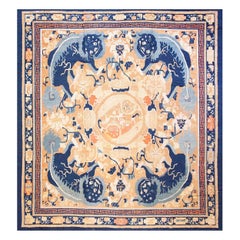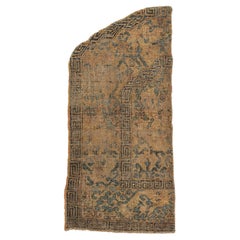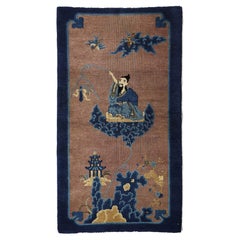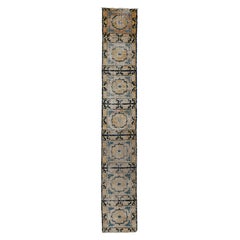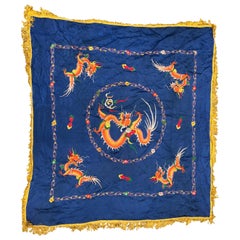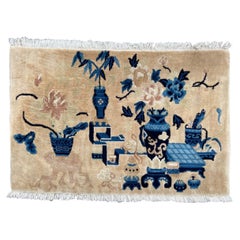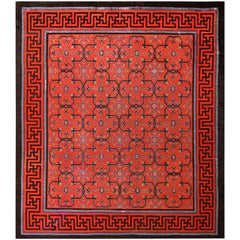Early 18th Century Chinese and East Asian Rugs
to
1
Width
to
Length
to
4
50
633
3,438
1,392
2,216
626
342
204
131
1,143
176
38
30
62
68
82
20
4
3
1
3
1
4
4
4
4
4
4
1
Period: Early 18th Century
18th Century Chinese Ningxia Main Hall Carpet ( 12'8''x13'4''- 385 x 405 )
Located in New York, NY
Main Hall Carpet
Ningxia
North Central China
First Half of the 18th century
Measures: 12'8" x 13'4" - 386 x 406 cm
Structural Analysis
Warp: cotton, white, natural, Z-4-S, hand-spun...
Category
Chinese Antique Early 18th Century Chinese and East Asian Rugs
Materials
Wool
Antique Silk Kashgar Throne Cover Rug Fragment
Located in Milan, IT
This very rare fragment belongs to a specific group of twelve silk Kashgar throne covers, all with a similar design and palette and distinguished by an ex...
Category
East Turkestani Khotan Antique Early 18th Century Chinese and East Asian Rugs
Materials
Silk
Late Ming c.a Antique Carpet with emperor on clouds
Located in Milano, IT
Behold, a magnificent antique carpet from the late Ming Dynasty period, a true testament to the artistry and craftsmanship of ancient China. Crafted from the finest wool and meticulo...
Category
Chinese Ming Antique Early 18th Century Chinese and East Asian Rugs
Materials
Wool
$16,771 Sale Price
20% Off
Distressed 18th Century Antique Ningxia Chinese Narrow Runner Rug
Located in Milan, IT
An exquisitely elegant early Temple runner from the Ningxia region in northwest China, commissioned in the early 18th century for a Buddhist monastery in Tibet. The pattern is compos...
Category
Chinese Ming Antique Early 18th Century Chinese and East Asian Rugs
Materials
Wool
Related Items
Beautiful Vintage Asian Dragon Embroidery
Located in Saint Ouen, FR
Nice embroidery panel with dragon design entirely hand embroidered with silk on silk
Dragon designs are on relief.
Category
Indonesian Chinoiserie Early 18th Century Chinese and East Asian Rugs
Materials
Silk
Bobyrug’s Beautiful Vintage Chinese Art Deco Little Rug
Located in Saint Ouen, FR
Exquisite Beijing Chinese rug adorned with a captivating design and vibrant colors. Meticulously hand-knotted with wool velvet on a cotton foundation. The intricate pattern, featurin...
Category
Chinese Chinoiserie Early 18th Century Chinese and East Asian Rugs
Materials
Wool
Small Late 19th Century Chinese Carpet with Salmon Pink Ground
Located in Firenze, IT
In the vast range of Chinese carpets, all Chinese civilization is represented and in the elements that make up the design, all Chinese philosophy is represented, the religions with B...
Category
Chinese Chinoiserie Antique Early 18th Century Chinese and East Asian Rugs
Materials
Wool
Chinese Carpet, circa 1920
Located in Rome, IT
A Chinese Carpet 1920 circa.
cm 530 x310
Category
Chinese Early 18th Century Chinese and East Asian Rugs
Materials
Wool
1920's Antique Blue Chinese Peking Carpet with Traditional Style
Located in Dallas, TX
77524 Antique Blue Chinese Peking Rug, 09'01 x 11'06. A rare and resplendent testament to the art of imperial refinement, this hand-knotted wool antique Chinese Peking rug is an obje...
Category
Chinese Chinoiserie Early 18th Century Chinese and East Asian Rugs
Materials
Wool
Beautiful antique silk Japanese Embroidery « the tigers »
Located in Saint Ouen, FR
Nice antique Japanese embroidery with beautiful design with tigers, and with nice natural colours in hues of yellow, green, brown and black , entirely...
Category
Japanese Chinoiserie Early 18th Century Chinese and East Asian Rugs
Materials
Silk
$2,329 Sale Price
20% Off
H 34.65 in W 55.91 in D 0.24 in
Antique Chinese Pictorial Tapestry with Traditional Crane Design
Located in Dallas, TX
77548, antique Chinese pictorial tapestry with traditional crane design. This hand knotted wool antique Chinese pictorial tapestry features a large red-crowned crane design set against an abrashed neutral field. The crane is depicted standing on one leg with its wings outstretched while perched atop a cliff alongside several bamboo plants. The crane is one of the most widely used symbols throughout Chinese art and literature and figures heavily in Chinese mythology. The creature is thought to represent longevity, immortality, nobility, and fidelity. It is often represented alongside bamboo, as it is in this piece, another symbol of longevity. The warm sepia backdrop recalls ancient Chinese scrolls...
Category
Chinese Ming Early 18th Century Chinese and East Asian Rugs
Materials
Wool
$1,599 Sale Price
20% Off
W 24 in L 49 in
Wonderful antique silk and golden metal Chinese rich Embroidery
Located in Saint Ouen, FR
Very beautiful and antique Chinese embroidery with beautiful design with birds, dogs, symbols and scriptures, and with nice natural colours with a red brown background, entirely hand...
Category
Chinese Chinoiserie Antique Early 18th Century Chinese and East Asian Rugs
Materials
Metal
$3,709 Sale Price
20% Off
H 46.46 in W 32.68 in D 0.24 in
Mid-20th Century Handmade Chinese Art Deco Room Size Carpet
Located in New York, NY
A vintage Chinese Art Deco room size carpet handmade during the mid-20th century.
Measures: 9' 2" x 11' 9"
Chinese Rugs & Carpet:
The craft of the hand-knotted carpet in China, and the surrounding areas including Mongolia and Tibet, extends into the early centuries of the first millennium, C.E., but we really have a firm grasp only beginning in the later 16th century with large, very coarsely woven carpets, often depicting dragons, created for the Imperial Forbidden City palaces. Chinese carpets have always been commercial and there are no tribal groups responsible for any of the carpet weaving strains.
When the Ming Dynasty fell in 1644, with no Imperial patrons, production moved to the city of Ningxia in north central China where several workshops turned out more finely woven pieces for the Mandarins of the administrative Ch’ing bureaucracy and well-to-do merchants. Ningxia was the major Chinese carpet center up through most of the 19th century, with first allover and then medallion designs on cotton foundations in medium weaves. Palettes were initially limited to yellows, dark blue and cream, but later widened to include reds, browns and even green. These antiques were the first Chinese carpets to be exported to the West and they fitted in well with the craze for Chinese blue-and-white porcelain in the second half of the 19th century. Ningxia also wove shaped and rectangular small rugs for saddle underlays, chair (“throne”) seats and shaped backs, pillar carpets with dragons or monks for Buddhist monasteries, and long divided runners for monastery meditation halls. These small rugs are among the most collectible of all Chinese weavings.
Weavers from Ningxia set up workshops in the capital Peking (Beijing) in the 1860’s and began weaving Western room sizes for export, primarily to America. In blue – and – white and polychrome palettes, with round wreath medallions, precious objects, seasonal flowers, paeonies, lotuses, fretwork, clouds, butterflies and bats, all relatively spaciously drawn. The round “Shou” (Good Luck) character is also a prominent decorative motif. There are also a few Peking landscape pictorials with pagodas, houses, bridges, waterscapes and boats. Peking carpets were woven right up until WWII and production began again after the Cultural Revolution around 1970. They are moderately well-woven, on cotton foundations, exactingly executed and indisputably Chinese. Many are in the blue-and-white style. Nothing else looks like a Peking carpet and for a Chinese “look” in a room, they are absolutely indispensable. Sizes range from scatters and a few runners, through the popular 9’12’ size, to large carpets over 20’ which must have been special orders. The earliest Peking Revival carpets are pliable and fairly thin, but they became heavier and more compact in the 20th century, in competition with Art Deco carpets from Tientsin. The modern, post- 1970, pieces are in the traditional Peking style, but are a little too regular and neat. Exactitude has been favored over character, as hard to explain that as it is.
There are a number of all-silk and silk-and –metal thread pieces, many with inscriptions purporting to link them with rooms in the Imperial palaces, bringing very substantial auction prices, but none are really antique. The genre emerged after WWI and the present demand comes from mainland Chinese. The silk piles often stand in pattern relief against flat woven gold metal thread grounds. The inscriptions are apocryphal, the rugs are flashily opulent, perfect for nouveaux riches.
The Art Deco period between the two World Wars saw a distinctive carpet industry developing in Tientsin (Tianjin) in northeastern China. These are highly prized for their transitional design character, neither overtly Chinese, nor abstractly modern/contemporary. Woven exclusively for export, usually by and for American firms, such as Nichols and Elbrook, they are totally in the “Jazz Age Modern” style of the 1920’s, often without borders, with abstract or abstracted patterns, and only with, at best, a few Chinese-y pattern elements. Vases asymmetrically placed in the corners are features of some of the more Chinese-y carpets. Open fields with floral sprays and branches growing in from the edges are anther design innovation. Often, Chinese motives have been re-imagined in more sharp-edged, abstract manners. Some have no references whatsoever to natural elements. The patterns are sharp and the rugs are never subdued, soft or restrained. The rugs are heavily constructed, with crisp, unfading dyes and medium to medium coarse weaves on cotton foundations. All are extremely well-executed, with none of the vagaries, variations or twists found on even high-quality Persian rugs. The majority are in the 9’ by 12’ format and a surprising number can be found in top condition. There also was a substantial production in Peking from, especially from the Fette factory. Elliptical and round carpets, and lighter, often pastel colors, were a specialty. Nothing looks like an Art Deco Chinese and they work well with traditional Chinese furniture and the most modern decor as well. These is no substitute for a good Chinese Art Deco carpet.
Chinese carpets also include small scatters from Tibet, with high quality wool, floating dragons and allover textile patterns. The colors of vintage and modern pieces are bright, but there are antique small rugs...
Category
Chinese Art Deco Early 18th Century Chinese and East Asian Rugs
Materials
Wool
Mid-20th Century Chinese Art Deco Room Size Carpet
Located in New York, NY
A vintage Chinese Art Deco room size carpet handmade during the Mid-20th Century.
Measures: 8' 11" x 11' 7".
Category
Chinese Art Deco Early 18th Century Chinese and East Asian Rugs
Materials
Wool
1900's Chinese Silk Tapestry with Qing Style
Located in Dallas, TX
71052 Rare Antique Chinese Silk Tapestry, 02'11 x 04'08. This exceptional antique handwoven Chinese silk tapestry is a masterwork of textile artistry—an exceedingly rare example of Q...
Category
Chinese Qing Early 18th Century Chinese and East Asian Rugs
Materials
Silk
Antique Chinese, Ningxia Rug
Located in New York, NY
Antique Chinese - Ningxia rug, size: 2'2" x 2'3".
Category
Chinese Antique Early 18th Century Chinese and East Asian Rugs
Materials
Wool
Previously Available Items
Early 18th Century Antique Chinese Geometric Rug. Size: 12 ft x 14 ft
Located in New York, NY
Antique Chinese Geometric rug, origin: China, circa early 18th century. Size: 12 ft x 14 ft (3.66 m x 4.27 m)
A wonderful example of a whole o...
Category
Chinese Chinese Export Antique Early 18th Century Chinese and East Asian Rugs
Materials
Wool
Recently Viewed
View AllMore Ways To Browse
Chinese Bronze Fish
Chinese Censor
Chinese Cloisonne Urn
Chinese Dreamstones
Chinese Gu Vase
Chinese Horse Screen
Chinese Porcelain Vase 2 Handles
Chinese Silk Tassel
Chinese Tulip Vase
Clam Dish
Coalport Cobalt Blue
Copper Pot China
Cordier Bronzes
Corroso Murano Vase
Counter Top Shop Display Cabinet
Cut Glass Candy Dish
Czech Glass Fruit
Dahl Jensen Figurine
